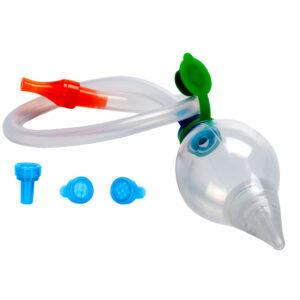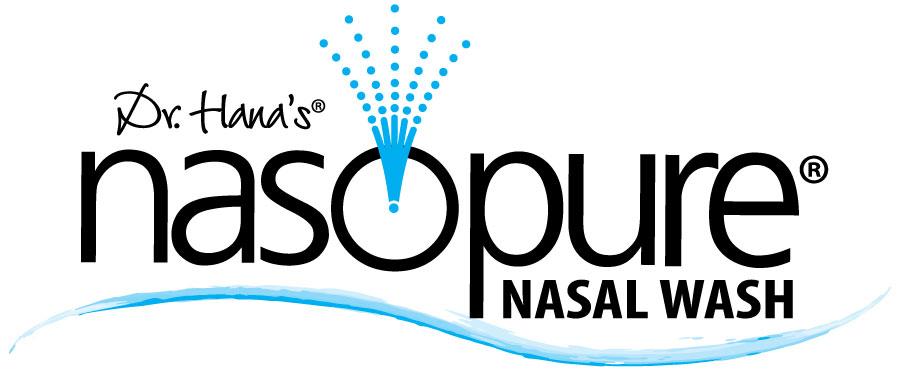Baby Nasal Cleaner – How to Clean a Newborn Baby or Infant Nose
Teaching parents the importance of maintaining baby’s clean nose has been a rewarding yet occasionally challenging task. Many gallons of air are passed through the nose every day and babies must breathe through their noses. They are ‘obligate nose breathers’. Suckling on mom’s breast requires breathing through the nose so washing the infant’s filter is vital. In fact infants need a clear nasal cavity for adequate nutrition, restful sleep and comfort. Sneezing is a newborns natural way of cleaning that nasal cavity. When excessive mucus builds up and dries, the nose requires cleaning and without the help of a nasal cleaner for babies, their body naturally sneezes to expel the blockage.
For many adults, the instinctual go to solution for nasal congestion is medicine. Even though an all-natural nasal wash is a better option for adults, it’s especially true for babies. The use of medications should be used rarely for babies, as decongestants can dry up mucus and plug up the drainage system. In addition, these drugs can cause sleeplessness. Antihistamines may cause sedation and thicken the discharge-the very last thing you want for your baby. A baby nasal cleaner will offer much more effective and affordable relief. Washing the nasal passages actually helps reduce the development of a number of infections. I know this to be true from my clinical practice, scientific studies will come in the future, I’m certain!
The process of cleaning your infant’s nose is really quite simple, but communicating the exact “how to” clean an infant or newborn baby nose is a bit difficult without live demonstrations but I’m going to try here.
Which Solution is Right for your Baby Nasal Cleaner
When using a nose cleaner for babies less than 3-6 months, always use an isotonic (milder) solution. Using a hypertonic (stronger) solution in older babies is fine as long as it is only slightly hypertonic.
When preparing a hypertonic (stronger) version add 1 1/2 salt packet rather than just 1. For babies older than 6 months, the Nasopure nasal wash for kids bottle is just the right size for both storage and application!
Be mindful not to squeeze more than a few drops of solution into your baby nose!
Definitions for these terms can be found on our Solutions Guide page. See below for instructions on How To Make A Saline Solution.
Steps How to Clean a Newborn Baby Nose
- You will need a good baby aspirator. I prefer the Neilmed Naspira baby aspirator because of the silicone-like tip and it is easy to use. I have used this for my own grand babies with excellent results.
1. Hold the baby in an upright to semi-upright position, well secured in your arms, and be sure that the baby is comfortable.
2. Place the tip of the bulb into the baby’s nostril and suck very gently through the mouthpiece, as if you are drinking a liquid from a straw. If needed, you can always use more suction force. The mouthpiece is a one-way valve and will not allow you to blow into the baby’s nose.
3. A pre-treatment with a few drops of saline solution or saline spray in each nostril may help loosen thick mucus before using the NeilMed® Naspira® Nasal-Oral Aspirator (NOA). Mucus from the baby’s nostrils will come out very easily and transfer mainly to the tip, and if excessive, into the bulbous area during suctioning.
4. Repeat the previous steps in the same and/or the other nostril as necessary.
5. Please follow the cleaning and disinfection protocol for the safety of yourself and your baby.
6. Change filter if it is soiled with secretions or after the acute infection is over or every week during use.
Aspirating your baby’s nose should be a gentle process – and when done correctly, it actually feels good to the baby. Stop the process and try again later if your baby resists vigorously. Always confirm you have a complete seal between tip and nostril and that the nozzle is directed back towards the baby’s neck, not upward towards the eyes, as shown in the photos. Holding the mouthpiece between your lips frees your hands to better position the child.
Stuffy babies also require extra moisture, so a vaporizer or humidifier near the infant’s crib at night can supply moist air. It is important to clean vaporizers and humidifiers weekly to avoid dispersal of fungal particles into the air. Clean with a diluted vinegar or bleach solution. Elevation of the baby’s head is also beneficial for effective drainage of congestion. I suggest placing a firm object such as books under the head end of your infant’s mattress.
How to Make Dr. Hana’s Saline Solution
NEED: Clean glass jar; water – distilled, sterile or previously boiled and brought to room temperature; Nasopure buffered salt packet (enclosed); dropper.
Add one salt packet to either one half or one full cup room temperature purified water. Mix with clean utensil. Do not touch the solution with your fingers!
One cup water to one packet makes a milder solution, best for infants below 3 months. One half cup water makes a stronger, saltier or hypertonic solution that loosens and thins the secretions.
 Again, as a board certified pediatrician, I can’t stress the importance of cleaning your baby’s nose enough. In my experience as a Pediatrician I’ve seen many infections, sleepless nights and uncomfortable situations avoided with simple baby nasal irrigation. Infants are dependent on their noses to intake oxygen more than any other age group and at such a vulnerable time in their lives, they need your help to breathe. A device for infant nose suction is affordable, easy to use and well worth the investment in your infant’s health.
Again, as a board certified pediatrician, I can’t stress the importance of cleaning your baby’s nose enough. In my experience as a Pediatrician I’ve seen many infections, sleepless nights and uncomfortable situations avoided with simple baby nasal irrigation. Infants are dependent on their noses to intake oxygen more than any other age group and at such a vulnerable time in their lives, they need your help to breathe. A device for infant nose suction is affordable, easy to use and well worth the investment in your infant’s health.
Contributor to MommyMD Guide: The Mommy MD Guide to Pregnancy and Birth; The Mommy MD Guide to Your Baby’s First Year; and the forthcoming The Mommy MD Guide to the Toddler Years
